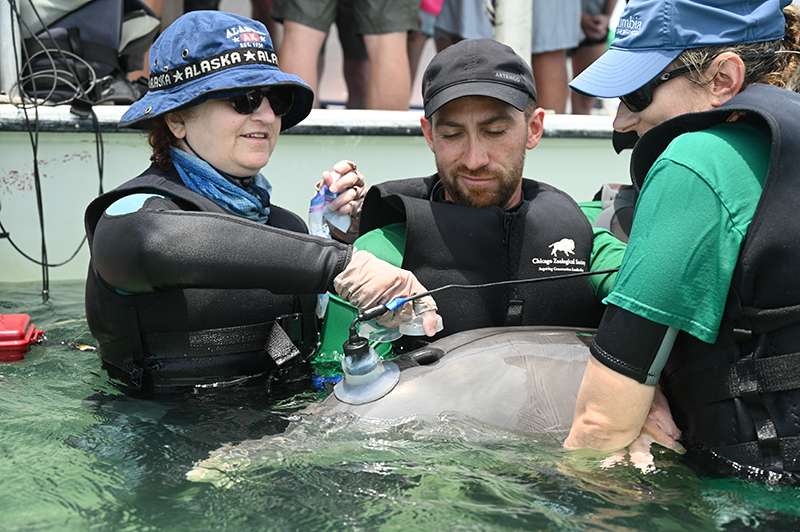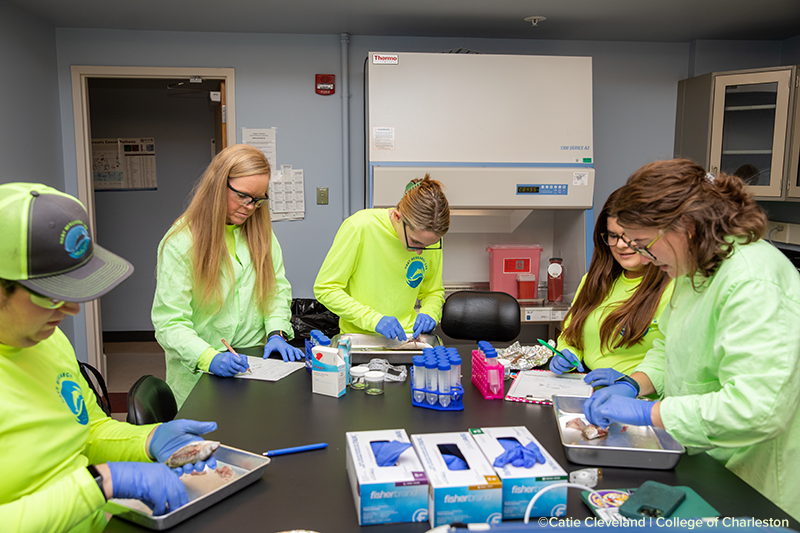Will Changing Weather Patterns Expose Dolphins to More Chemicals?
Sarasota Bay, Florida, study aims to understand whether excess rainfall and red tides impact the concentration of chemical contaminants in dolphins
Since 2016, the College of Charleston and its partners at the Sarasota Dolphin Research Program (SDRP) have been studying plastics pollution exposure in Sarasota Bay’s bottlenose dolphins. The studies have found plastics in dolphin stomach contents and breath, as well as chemicals used to make them — called phthalates — in their urine.
Now, a new study is investigating how climate-influenced events like major storms, rainfall, and red tides impact phthalate exposure and health of Sarasota Bay dolphins.

A member of the SDRP research team holds a petri dish over a dolphin’s blowhole to collect a breath sample during a health assessment.
Phthalates — used to make plastics flexible and more durable and as solvents and stabilizers — have been nicknamed the “everywhere chemical” because they’re so widespread in our daily lives. These chemicals, which are easily released as plastics break down, are found in everything from PVC pipes, to food packaging and even cosmetics and perfumes. Exposure is so common that more than 95 percent of humans have detectible levels in their urine.
Our recent research has shown that approximately 75% of Sarasota Bay dolphins have detectable levels of phthalates in their bodies. The levels in Sarasota Bay dolphins are higher than concentrations found during human studies.
This phthalate exposure is a concern for dolphins because these ubiquitous chemicals are known endocrine disruptors that impact mammals’ hormone systems. Hormonal changes can cause problems with growth, fertility and reproduction, which could have population-level impacts on dolphins. Human studies have also shown that phthalates can lead to heart problems and even neurological disorders.
By analyzing urine samples collected over three decades, we aim to identify environmental influences on phthalate exposure and links to endocrine disruption, reproductive issues, growth abnormalities, and cardiovascular health. This study will provide valuable insights into how environmental changes can impact dolphin exposure to these chemicals of emerging concern.
“In previous studies, we found that there were unexplained differences in phthalate concentrations in Sarasota Bay dolphins, depending on when urine samples were collected and what part of the Bay the dolphins frequented,” said Dr. Leslie Hart, Associate Professor at the College of Charleston and the project’s lead researcher. “Through this study, we’re trying to tease out the factors that could account for some of the differences.”

Dr. Leslie Hart, second from left, and her students process fish samples to test for plastics.
Previous environmental studies in other parts of the world have shown that phthalate contamination can increase when rainfall causes excess runoff and flooding, so the team is comparing tropical storm and rainfall records for the Sarasota Bay area to the phthalate levels in the Bay’s dolphins using archived urine samples from 202 animals.

Dr. Randy Wells
And, because previous SDRP studies have shown that dolphins are forced to eat different prey items when fish populations decline during red tides — which could also impact phthalate levels — the team is comparing the urine samples with archived cell counts of the dinoflagellate that causes red tide blooms (Karenia brevis).
“Long-term forecasts predict increasingly warmer ocean temperatures, which provide fuel for tropical storms and hurricanes that can bring flooding and excess runoff from land,” Hart said. “As these waters drain into our local bays, they carry nutrients and chemicals, including phthalates and plastics, from the land, increasing the risk of contaminant exposure for local dolphin populations. Additionally, red tide blooms, driven by nutrient inputs, often lead to fish die-offs, potentially increasing trophic-associated exposure to phthalates and plastics.”
The study is funded by Sea Grant (Award No. NA22OAR4170655 – CFDA #11.417) and made possible thanks to the data gathered about the long-term resident dolphins of Sarasota Bay over more than 54 years through the Sarasota Dolphin Research Program, the world’s longest-running dolphin conservation research program. The SDRP conducts periodic catch-and-release health assessments to monitor the Bay’s dolphins. During these veterinary check-ups, the researchers gather a variety of biological samples used for various studies. Unused samples are stored for future work as new research questions arise.
“As phthalates have become ubiquitous in our environment, there’s a growing concern over what the impacts could be,” said Dr. Randy Wells, Director of the SDRP and Vice President of Marine Mammal Conservation at Brookfield Zoo Chicago, which operates the program. “If humans are causing disturbances to things like dolphin reproduction because of plastics and chemicals from plastics, wildlife managers need to know that so they can work to mitigate the risks. Over more than five decades, Sarasota Bay has served as a natural laboratory where we can answer critically important questions like this.”
Additional investigators on the project are: Dr. Krystan Wilkinson, Staff Scientist, Sarasota Dolphin Research Program, Miranda Dziobak, Public Health Instructor, College of Charleston, Nadine Slimak, Vetted Communications, and Kylie Warden, graduate student at the College of Charleston.




